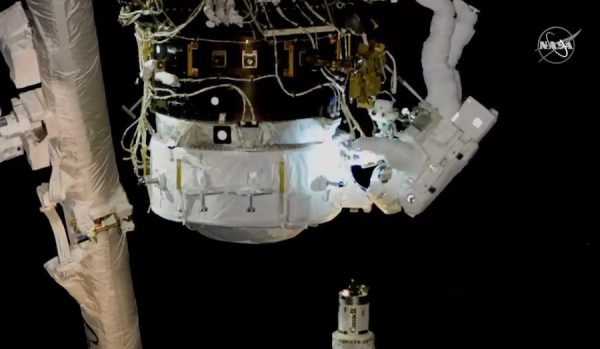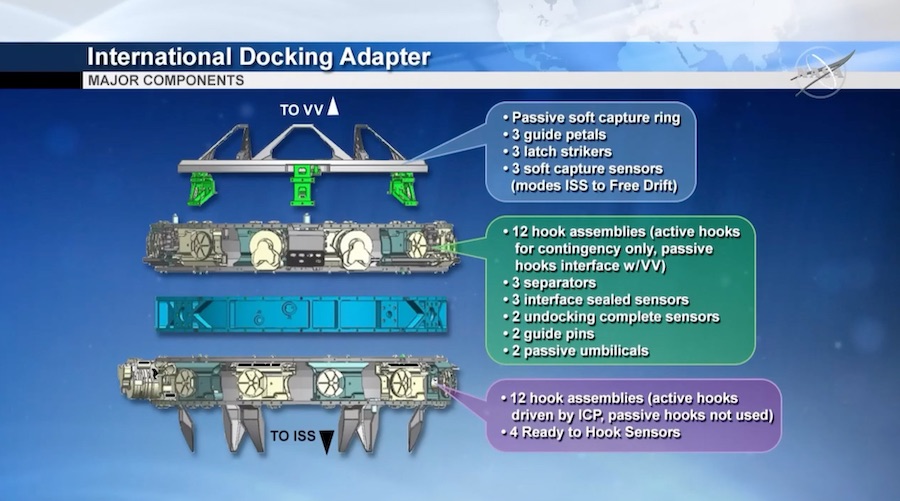Spacewalkers help install new space station docking port – Spaceflight Now

NASA astronauts Nick Hague and Drew Morgan completed a 6-hour, 32-minute spacewalk outside the International Space Station Wednesday to help connect a newly-arrived docking port to the orbiting research outpost.
The astronauts switched their spacesuits to internal battery power at 8:27 a.m. EDT (1227 GMT) Wednesday, marking the official start of Wednesday’s spacewalk as they headed outside the space station’s Quest airlock.
On Monday, the space station’s Canadian-built robotic arm pulled the International Docking Adapter-3, or IDA-3, from the trunk of a SpaceX Dragon cargo craft, which delivered the docking mechanism to the station last month.
The docking system, built by Boeing, is a replacement for the IDA-1 docking adapter destroyed on a 2015 SpaceX launch failure. IDA-3 cost around $22.5 million, a NASA spokesperson said in response to questions from Spaceflight Now.
SpaceX successfully delivered IDA-2 to the station on a Dragon mission in 2016, and the new docking mechanism was first used in March by SpaceX’s Crew Dragon spacecraft on an unpiloted test flight before officials clear astronauts to ride the vehicle.
After removing IDA-3 from the Dragon’s aft trunk section Monday, the space station’s robotic arm placed it on Pressurized Mating Adapter-3, the space-facing zenith port of the space station’s Harmony module. IDA-2 is located on the Harmony forward port.
IDA-3 weighed around 1,177 pounds (534 kilograms) before launch. The docking adapter measures about 42 inches (1.1 meters) tall and 63 inches (1.6 meters) wide.
Both docking adapters are designed to fit over disused docking ports designed for visiting space shuttles, but new commercial crew capsules built by Boeing and SpaceX use a different docking system design. The addition of two IDAs on the station allows Boeing’s Starliner and SpaceX’s Crew Dragon capsules to park at the complex at the same time, using two separate docking adapters.
SpaceX future Dragon cargo vehicles will also dock with one of the IDAs on the station.
“As we rotate crews through the vehicle, we want to have them time to directly hand over face-to-face, so enabling those two docked vehicles is very important,” said Bill Spetch, NASA’s deputy manager of space station transportation integration, in a press conference before IDA-3’s launch July 25 from Cape Canaveral aboard the Dragon cargo ship.
During Wednesday’s spacewalk, Hague and Morgan connected power and data cables between the space station’s Pressurized Mating Adapter-3 and IDA-3. The connectors power sensors, heaters and other mechanisms inside the docking system.
After the spacewalkers installed the first set of cables, astronaut Christina Koch inside the space station commanded a series of 12 hooks to close, completing a firm structural connection between IDA-3 and PMA-3.
Hague and Morgan then routed another set of cables to power IDA-3, removed a thermal cover from the docking adapter, and covered a rendezvous reflector aid on PMA-3 once used by arriving space shuttles. The astronauts added new laser retroreflectors on IDA-3 to be used by rendezvous sensors on Starliner and Crew Dragon spaceships.

The astronauts returned to the Quest module and began repressurizing the airlock at 2:59 p.m. EDT (1829 GMT), bringing the spacewalk to a close.
Hague was designated EV-1, or the lead spacewalker, on Wednesday’s excursion. Morgan, on his first spacewalk, was designated EV-2.
Wednesday’s spacewalk was the third in Hague’s career. With the time accumulated on Wednesday’s excursion, Hague has logged 19 hours, 56 minutes, of spacewalking time.
The spacewalk to outfit IDA-3 was the fifth spacewalk conducted from the space station this year, and the 218th spacewalk since 1998 in support of station assembly, maintenance and upgrades, according to NASA.
Email the author.
Follow Stephen Clark on Twitter: @StephenClark1.






